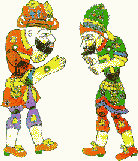Karagoz & Hacivat is a Turkish shadow play taking its name from its main character Karagöz. The origin of the shadow plays is accepted as southeastern part of Asia around Java. Turkish traveler Evliya Çelebi said that the play was first performed at the Ottoman palaces in the late 14th century. Some others say that this play came into Anatolia after Yavuz Sultan Selim, who had conquered Egypt in 1517, had brought the shadow play artists to his court.
 According to a legend, they were working as construction workers in a mosque in Bursa. Although their satiric jokes entertained other workers it also held up the building of the mosque by their constant joking together. As a result it made the sultan very angry and anxious about whether Karagoz and Hacivat could encourage rebellion in others, so they were executed. The construction of the mosque was completed without them, but their comrades did not forget them and kept their jokes alive, telling them over and over. In time, the adventures of Karagoz and Hacivat gained a new dimension and the traditional Turkish shadow puppet theater was born. Their monumental tomb stands in Bursa city today.
According to a legend, they were working as construction workers in a mosque in Bursa. Although their satiric jokes entertained other workers it also held up the building of the mosque by their constant joking together. As a result it made the sultan very angry and anxious about whether Karagoz and Hacivat could encourage rebellion in others, so they were executed. The construction of the mosque was completed without them, but their comrades did not forget them and kept their jokes alive, telling them over and over. In time, the adventures of Karagoz and Hacivat gained a new dimension and the traditional Turkish shadow puppet theater was born. Their monumental tomb stands in Bursa city today.
Karagoz & Hacivat plays were the most enjoyed entertainment of the Ottoman period and was widely performed for the public and in private houses between the 17th and 19th centuries especially during Ramadan, and at circumcisions, feast festivals, coffee houses and even in gardens.
Karagöz play is played depending on the talent of an artist. Moving the design on curtain, voicing them, dialects or imitations are all made by the artist. The subjects of Karagöz plays are funny elements with double meanings, exaggerations, verbal plays, and imitating accents. There is always satire and irony.
These puppets with jointed limbs are 35-40 centimeters (14-16 inches) sized and they are generally made from the skin of camel or cows. The skins are made semi-transparent and painted with Indian ink or root paints. Then they are embroidered with sharp painted blades and the pieces are tied with ropes. This is truly an art.
The white curtain on which Karagöz is played is named as Ayna (mirror in Turkish), and the light behind it as Sema (candle light). There is just one puppeteer, known as Hayali (imaginary), assisted by an apprentice, who installs the curtain and brings the puppets in order of appearance.
The main characters of the play are of course Karagoz and Hacivat. Karagoz represents the public morals and common sense, the ordinary man in the street, and is straightforward and reliable. He is almost illiterate; usually unemployed and embarks on money earning projects that never work. He is often kind of rude. You can recognize him by his turban, his bald head and his black beard. His left arm is longer than the other one. His friend Hacivat instead is the opposite of him; he is educated in a theological school and uses poetical and literary language. He's very clever as well.
Today a limited number of artists continue the studies related to the art of Hacivat & Karagoz and they're conducted by the Presidency of Turkey National Center of International Puppet and Shadow Play Union (UNIMA) and the Ministry of Culture.

